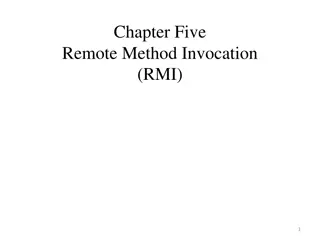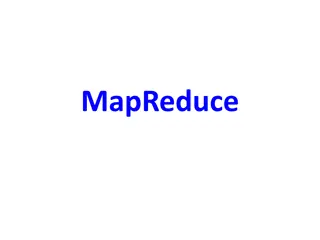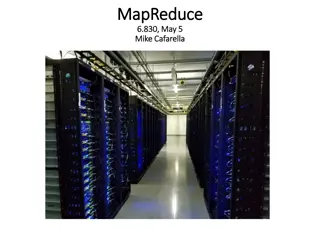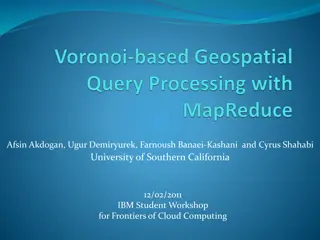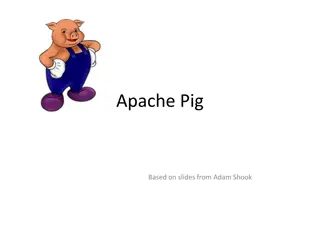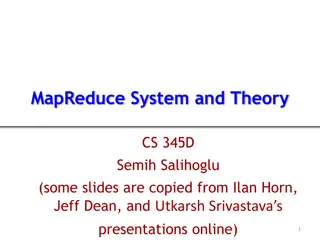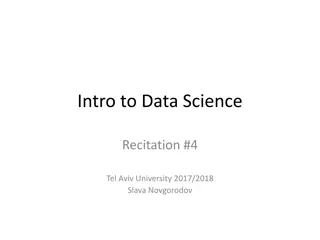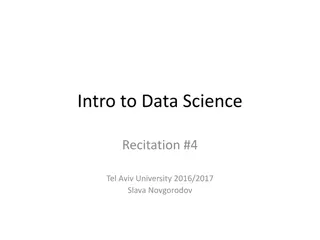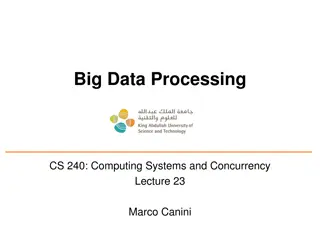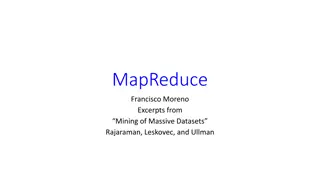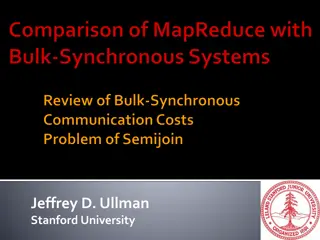Understanding MapReduce in Distributed Systems
MapReduce is a powerful paradigm that enables distributed processing of large datasets by dividing the workload among multiple machines. It tackles challenges such as scaling, fault tolerance, and parallel processing efficiently. Through a series of operations involving mappers and reducers, MapReduce simplifies the processing of vast amounts of data, offering an open-source implementation through Apache Hadoop. This approach enhances data processing capabilities by leveraging commodity servers and emphasizing scalability and fault tolerance.
Download Presentation

Please find below an Image/Link to download the presentation.
The content on the website is provided AS IS for your information and personal use only. It may not be sold, licensed, or shared on other websites without obtaining consent from the author. Download presentation by click this link. If you encounter any issues during the download, it is possible that the publisher has removed the file from their server.
E N D
Presentation Transcript
MapReduce B.Ramamurthy & K.Madurai 1
Motivation Process lots of data Google processed about 24 petabytes of data per day in 2009. A single machine cannot serve all the data You need a distributed system to store and process in parallel Parallel programming? Threading is hard! How do you facilitate communication between nodes? How do you scale to more machines? How do you handle machine failures? B.Ramamurthy & K.Madurai 2
MapReduce MapReduce [OSDI 04] provides Automatic parallelization, distribution I/O scheduling Load balancing Network and data transfer optimization Apache Hadoop: Open source implementation of MapReduce Fault tolerance Handling of machine failures Need more power: Scale out, not up! Large number of commodity servers as opposed to some high end specialized servers B.Ramamurthy & K.Madurai 3
MapReduce workflow Input Data Output Data Worker Output File 0 write Worker local write Split 0 Split 1 Split 2 read Worker Output File 1 Worker Worker remote read, sort Map Reduce aggregate, summarize, filter, or transform extract something you care about from each record B.Ramamurthy & K.Madurai 5
Mapper and Reducer MapReduceTask Mapper Reducer Counter YourReducer Parser YourMapper Remember: MapReduce is simplified processing for larger data sets: MapReduce Version of WordCount Source code B.Ramamurthy & K.Madurai 6
Map Operation web 1 MAP: Input data <key, value> pair weed 1 green 1 web 1 sun 1 weed 1 moon 1 green 1 land 1 sun 1 web 1 part 1 moon 1 Map weed 1 web 1 land web 1 1 Data green 1 green 1 part weed 1 1 Split the data to Supply multiple processors sun 1 Collection: split1 web 1 1 web green 1 1 moon 1 weed 1 KEY VALUE land green sun 1 1 1 green 1 moon 1 1 part 1 sun 1 KEY land VALUE 1 web 1 moon 1 part 1 green 1 Map Data land 1 web 1 1 part 1 Collection: split 2 VALUE green 1 KEY web 1 1 green 1 KEY VALUE 1 KEY VALUE Data Collection: split n B.Ramamurthy & K.Madurai 7
Reduce Operation MAP: Input data <key, value> pair REDUCE: <key, value> pair <result> Reduce Map Data Split the data to Supply multiple processors Collection: split1 Reduce Map Data Collection: split 2 Data Reduce Map Collection: split n B.Ramamurthy & K.Madurai 8
Large scale data splits Map <key, 1> Reducers (say, Count) Parse-hash Count P-0000 , count1 Parse-hash Count P-0001 , count2 Parse-hash Count P-0002 ,count3 Parse-hash B.Ramamurthy & K.Madurai 9
MapReduce Example in operating systems command part0 combine map reduce Cat split part1 reduce map combine split Bat part2 map combine split reduce Dog map split Other Words (size: TByte) B.Ramamurthy & K.Madurai 10
MAPREDUCE PROGRAMMING MODEL B.Ramamurthy & K.Madurai 11
MapReduce programming model Determine if the problem is parallelizable and solvable using MapReduce (ex: Is the data WORM?, large data set). Design and implement solution as Mapper classes and Reducer class. Compile the source code with hadoop core. Package the code as jar executable. Configure the application (job) as to the number of mappers and reducers (tasks), input and output streams Load the data (or use it on previously available data) Launch the job and monitor. Study the result. Detailed steps. 12
MapReduce Characteristics Very large scale data: peta, exa bytes Write once and read many data: allows for parallelism without mutexes Map and Reduce are the main operations: simple code There are other supporting operations such as combine and partition (out of the scope of this talk). All the map should be completed before reduce operation starts. Map and reduce operations are typically performed by the same physical processor. Number of map tasks and reduce tasks are configurable. Operations are provisioned near the data. Commodity hardware and storage. Runtime takes care of splitting and moving data for operations. Special distributed file system. Example: Hadoop Distributed File System and Hadoop Runtime. B.Ramamurthy & K.Madurai 13
Classes of problems mapreducable Benchmark for comparing: Jim Gray s challenge on data-intensive computing. Ex: Sort Google uses it (we think) for wordcount, adwords, pagerank, indexing data. Simple algorithms such as grep, text-indexing, reverse indexing Bayesian classification: data mining domain Facebook uses it for various operations: demographics Financial services use it for analytics Astronomy: Gaussian analysis for locating extra-terrestrial objects. Expected to play a critical role in semantic web and web3.0 14
Example: Word Count http://kickstarthadoop.blogspot.ca/2011/04/word-count-hadoop-map-reduce-example.html B.Ramamurthy & K.Madurai 16
MapReduce Hadoop Program fork fork fork Master assign map assign reduce Input Data Output Data Worker Output File 0 write Transfer Worker local write Split 0 Split 1 Split 2 read peta- scale data through network Worker Output File 1 Worker Worker remote read, sort Map Reduce B.Ramamurthy & K.Madurai 19
Google File System (GFS) Hadoop Distributed File System (HDFS) Split data and store 3 replica on commodity servers B.Ramamurthy & K.Madurai 20
MapReduce HDFS NameNode Where are the chunks of input data? Location of the chunks of input data Master assign map assign reduce Input Data Output Data Worker Split 0 Output File 0 write Worker local write Split 0 Split 1 Split 2 Worker Split 1 Output File 1 Worker Worker Split 2 remote read, sort Read from local disk Map Reduce B.Ramamurthy & K.Madurai 21
Failure in MapReduce Failures are norm in commodity hardware Worker failure Detect failure via periodic heartbeats Re-execute in-progress map/reduce tasks Master failure Single point of failure; Resume from Execution Log Robust Google s experience: lost 1600 of 1800 machines once!, but finished fine B.Ramamurthy & K.Madurai 23
Mapper Reducer Run this program as a MapReduce job B.Ramamurthy & K.Madurai 28
Summary MapReduce Programming paradigm for data-intensive computing Distributed & parallel execution model Simple to program The framework automates many tedious tasks (machine selection, failure handling, etc.) B.Ramamurthy & K.Madurai 29
Motivation: Large Scale Data Storage Manipulate large (Peta Scale) sets of data Large number of machine with commodity hardware Component failure is the norm Goal: Scalable, high performance, fault tolerant distributed file system B.Ramamurthy & K.Madurai 30
Why a new file system? None designed for their failure model Few scale as highly or dynamically and easily Lack of special primitives for large distributed computation B.Ramamurthy & K.Madurai 31
What should expect from GFS Designed for Google s application Control of both file system and application Applications use a few specific access patterns Append to larges files Large streaming reads Not a good fit for low-latency data access lots of small files, multiple writers, arbitrary file modifications B.Ramamurthy & K.Madurai 32
Components Master (NameNode) Manages metadata (namespace) Not involved in data transfer Controls allocation, placement, replication Chunkserver (DataNode) Stores chunks of data No knowledge of GFS file system structure Built on local linux file system www.cse.buffalo.edu/~okennedy/courses/cs e704fa2012/2.2-HDFS.pptx B.Ramamurthy & K.Madurai 34
GFS Architecture B.Ramamurthy & K.Madurai 35
Write(filename, offset, data) 1) Who has the lease? 4) Commit Client Master 2) Lease info 3) Data push Primary Replica Control 7) Success Data 6)Commit ACK 3) Data push Secondary ReplicaA 5) Serialized Commit 6)Commit ACK 3) Data push Secondary ReplicaB B.Ramamurthy & K.Madurai 37
RecordAppend (2) Record size is limited by chunk size When a record does not fit into available space, chunk is padded to end and client retries request. B.Ramamurthy & K.Madurai 38
Fault tolerance Replication High availability for reads User controllable, default 3 (non-RAID) Provides read/seek bandwidth Master is responsible for directing re-replication if a data node dies Online checksumming in data nodes Verified on reads B.Ramamurthy & K.Madurai 39
Replica Management Bias towards topological spreading Rack, data center Rebalancing Move chunks around to balance disk fullness Gently fixes imbalances due to: Adding/removing data nodes B.Ramamurthy & K.Madurai 40
Replica Management (Cloning) Chunk replica lost or corrupt Goal: minimize app disruption and data loss Approximately in priority order More replica missing-> priority boost Deleted file-> priority decrease Client blocking on a write-> large priority boost Master directs copying of data Performance on a production cluster Single failure, full recovery (600GB): 23.2 min Double failure, restored 2x replication: 2min B.Ramamurthy & K.Madurai 41
Limitations Master is a central point of failure Master can be a scalability bottleneck Latency when opening/stating thousands of files Security model is weak B.Ramamurthy & K.Madurai 42
Conclusion Inexpensive commodity components can be the basis of a large scale reliable system Adjusting the API, e.g. RecordAppend, can enable large distributed apps Fault tolerant Useful for many similar apps B.Ramamurthy & K.Madurai 43




